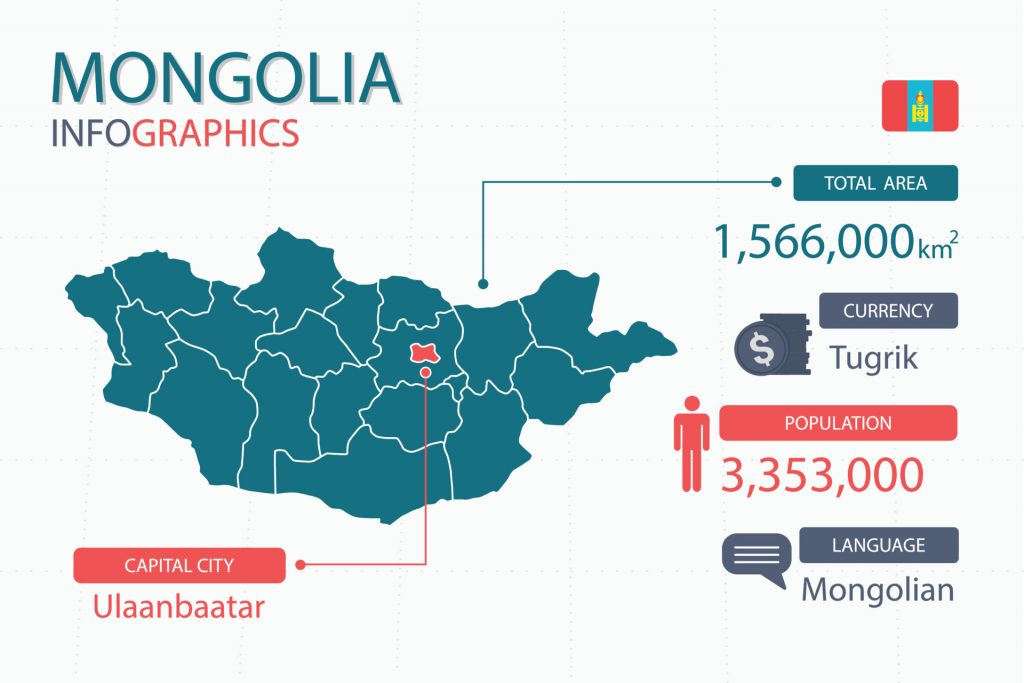The origins of the Mongolian Language
Mongolian is the official language of Mongolia and also an official language in the Inner Mongolia Autonomous Region in the People’s Republic of China. Overall, there are about 5.2 million speakers based on most recent estimates. In Mongolia, the Khalkha dialect of Mongolian is spoken, which is the de facto national language.
Unlike other languages where there are more than one variety, such as with British English and American English, grammar among the different varieties of Mongolian is not as uniform. There are vast differences between the Khalkha Mongolian spoken in Mongolia, and the Chakhar and Khorchin varieties most prominently spoken in Inner Mongolia. Mongolian is an agglutinative language; where different grammatical morphemes, units of meaning, combine to create more nuanced and complex meanings. Similar languages include Korean and Japanese. It also has a case system, meaning that there are suffixes that are added to identify the grammatical role of elements of a sentence. Thus, word order in Mongolian can be flexible at times, even though it mostly is a language where verbs come at the end.
Mongolian stems from the Mongolic language family, making it generally distinct from the majority of other languages, even though some scholars believe that it may have close relations to languages in Donhu, Wuhuan, and Xianbei. It includes a plethora of loanwords. A lot of these come from more ancient languages, including Arabic, Chinese varieties, Old Turkic, Sanskrit, Tibetan, and Tungusic, with these influences being attributed to close geography in general. More recent loanwords come from Russian, English, and specifically for varieties spoken in Inner Mongolia, Mandarin Chinese. In Mongolia, there is a language commission at work, however, working on translating loan words into ones that are more Mongolian, etymologically.

Mongolian is written with a number of writing systems, and this depends on the region in which Mongolian is spoken. In fact, the Mongolian language has the honor of being the language with the largest number of scripts used to write it throughout history. In Inner Mongolia, it is written using the traditional Mongolian script that has been used among Mongols nationwide. This script is a vertical script, written from the top-to-bottom. In addition, the columns are also written from left-to-right. In fact, it is the only vertical script in the world that is written from left-to-right. The Mongolian script is based on an Old Uyghur script and was developed at the end of the 14th century.
In Mongolia, the Cyrillic script is also used, and was introduced in the 1940s due to an influence from the Soviet Union and politics at that time. The Cyrillic Script is the same writing system used for a number of other languages, most notably Russian. After the Mongolian revolution in 1990, there was an attempt to use convert completely to the traditional Mongolian script, but this script was deemed to have too many disadvantages, especially for more technological purposes, such as typing. Unlike other vertical scripts, such as the Chinese writing system, it is not easy to convert it to a horizontal writing system, would be beneficial for endeavors such as typing and other digital aspects of the language. Therefore, both the traditional and Cyrillic scripts are taught in Mongolia to students in primary and secondary school.
The earliest evidence of Mongolia dates back to texts existing in 1224 or 1225 AD, with a report on a sports event that was written in Mongolian. Much other information about the Mongolian language is not available before this. In the 13th century, there was a Mongolian-Armenian wordlist which was compiled, but only containing about 55 words. Between the 13th and 15th century, there were texts with Mongolian, and written with four different scripts, which included Arabic, Chinese, a script called Phags-pa, and a script based on Uyghur. At this time, Mongolian was also spoken by the Mongol Empire, especially during the 13th and 14th century. In fact, the Yuan dynasty referred to it as their national language in China. However, the term “national language” was used to refer to a number of other languages based on differently dynasties, and a small number of scholars disagree on what this designation may have meant.
Classical Mongolian refers to the Mongolian spoken between the 17th and 19th century. At this time, the written language underwent an extremely high degree of standardization, especially in the realms of orthography and syntax. It is also quite different than modern Mongolian, as well as the Mongolian iteration spoken before this period. First, there was a major shift in the vowel system, and long vowels emerged. Second, the case system drastically changed. Lastly, the verbal system evolved, changing the grammatical structure a bit. Interestingly, current Mongolian literature is based more on these older versions of Mongolian. Also, due to a heavy Buddhist influence, the Soyombo script, which was developed for Buddhist texts was also employed to write Mongolian. There were many translation of Buddhist texts into the Mongolian language, and this affected language development as the vocabulary level as well, as many religious terms started to enter the language, especially in relation to more spiritual aspects such as astronomy and even more basic concepts such as the calendar.
Modern Mongolian can be said to have occurred in the 19th century. At this time, the spoken and written varieties were more aligned with people writing in a way that more resembled local speech. Nowadays, it is an important language in both Mongolia and Inner Mongolia (China). In Mongolia, with the traditional script being used to preserve more traditional cultural aspects, and with Cyrillic being used for more practical purposes, the language continues to survive and evolve with other modern day languages.
VEQTA can provide you with a perfect Mongolian translator for your Mongolian translation, English to Mongolian translation and Mongolian to english translation for the your targeted locale. Our translations to Mongolian are created with your target audience in mind to meet your expectations.
If you need to translate Mongolian – Get in touch today!
A dedicated team of Mongolian translators who combines Experience, Specialized Subject Matter Expertise with best Translation Practices to deliver quality second to none.
Mongolian Subject Expertise
Mongolian Translators
Mongolian Editors
Mongolian Copywriters
Mongolian Reviewers
Mongolian Voice dubbing
Mongolian Subtitling
Mongolian Transcription


